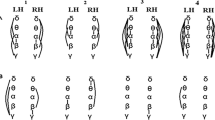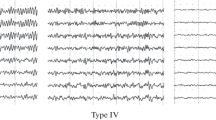Abstract
The individual characteristics of regional interhemisphere relationships were studied during acquisition of a food-related conditioned reflex in dogs. Electrical activity was recorded from symmetrical anterior (frontal and motor) and posterior (auditory and visual) areas of the brain. Comparison of averaged intrahemisphere EEG coherence values in the left and right hemispheres of the brain revealed individual features of regional interhemisphere relationships. In dogs with the strong type of nervous system, higher levels of EEG coherence in the anterior areas of the cerebral cortex were seen in the left hemisphere, while coherence in the posterior areas was greater in the right hemisphere. The opposite pattern was seen in animals with the weak type of nervous system. Thus, the spatial organization of cortical electrical activity differed in the associative and projection areas.
Similar content being viewed by others
References
N. I. Aleksandrova, “Correlation analysis of the bioelectrical activity of the anterior and posterior areas of the brain,” in: Questions of Differential Psychophysiology of Electrophysiological Investigations of the Basic Properties of the Nervous System [in Russian], Nauka, Moscow (1974), pp. 112–145.
V. L. Bianki, Asymmetry in the Brains of Animals [in Russian], Nauka, Leningrad (1985).
V. L. Bianki, Mechanisms of the Paired Brain [in Russian], Nauka, Leningrad (1989).
G. T. Bozhko, “Interhemisphere asymmetry of transcallosal influences in the projection and associative areas of the cat neocortex,” in: Neurobiology of Cerebral Lateralization. Studies at the Biological Science Research Institute of Leningrad State University [in Russian], Leningrad State University Press (1989), No. 40, pp. 5–26.
G. N. Boldyreva, I. S. Dobronravova, E. V. Sharova, and L. A. Zhavoronkova, “Reflection of adaptive rearrangements of the human brain in conditions of impaired cerebral functions in measures of interhemisphere asymmetry of EEG coherence,” Zh. Vyssh. Nerv. Deyat., 43, No. 2, 247–255 (1993).
N. V. Vol’f, Sexual Dimorphism in the Functional Organization of the Hemisphere Processing of Speech Information [in Russian], TsVVZ Press, Rostov-on-Don (2000).
V. N. Dumenko, “Regional characteristics of the electrical activity of the dog neocortex over a wide frequency range,” Zh. Vyssh. Nerv. Deyat., 35, No. 2, 288–296 (1985).
A. M. Ivanitskii, “Foci of interaction, information synthesis, and mental activity,” Zh. Vyssh. Nerv. Deyat., 43, No. 2, 219–227 (1993).
O. I. Ivashchenko, A. V. Berus, A. B. Zhuravlev, and V. V. Myamlin, “Individual-typological characteristics of basal personality properties in normal conditions and their EEG correlates,” Fiziol. Cheloveka, 25, No. 2, 46–55 (1999).
V. N. Kiroi, Mechanisms of the Formation of the Functional State of the Human Brain [in Russian], Rostov State University, Rostov-on-Don (1991).
É. A. Kostandov, T. F. Gavrilenko, and Yu. L. Arzumanov, “Interhemisphere functional relationships during the formation of temporal associations in humans,” Zh. Vyssh. Nerv. Deyat., 30, No. 5, 899–907 (1980).
G. A. Kuraev, Functional Asymmetry in the Cerebral Cortex and Learning [in Russian], Rostov State University, Rostov-on-Don (1982).
M. N. Livanov and V. N. Dumenko, “The neurophysiological aspect of studies of the systems organization of brain activity,” Zh. Vyssh. Nerv. Deyat., 18, No. 3, 6–16 (1987).
I. V. Pavlova, “Spike activity of individual neurons in the rabbit brain in conditions of natural food motivation,” Zh. Vyssh. Nerv. Deyat., 45, No. 6, 1202–1205 (1995).
R. A. Pavlygina and Yu. V. Lyubimova, “Spectral characteristics of brain electrical activity in rabbits in the state of hunger,” Zh. Vyssh. Nerv. Deyat., 44, No. 1, 54–64 (1994).
L. A. Preobrazhenskaya, “Individual characteristics of dogs in conditions of free choice between the probability and value of food reinforcement,” Zh. Vyssh. Nerv. Deyat., 47, No. 3, 487–499 (1997).
L. A. Preobrazhenskaya, “Asymmetry in activity between the hemispheres in the dog brain in the state of calm waking and during the action of sensory stimuli and food deprivation,” Zh. Vyssh. Nerv. Deyat., 49, No. 2, 287–300 (1999).
L. A. Preobrazhenskaya, “Dynamics of conditioned reflex changes in the EEG in symmetrical areas of the neocortex in dogs,” Zh. Vyssh. Nerv. Deyat., 52, No. 4, 441–449 (2002).
L. P. Rudenko, “Individual characteristics of behavior in dogs in conditions of conflict between the probability and quality of reinforcement,” Zh. Vyssh. Nerv. Deyat., 38, No. 3, 443–453 (1988).
V. C. Rusinov and O. M. Grindel’, “The optimal structure of links between electrical processes in the human cerebral cortex and impairments in altered states,” Zh. Vyssh. Nerv. Deyat., 38, No. 6, 995–1002 (1988).
N. A. Ryabchikova, E. V. Pod"yacheva, E. S. Tomilovskaya, and V. V. Shul’govskii, “The role of interhemisphere neurodynamics in the process of probabilistic prediction,” Zh. Vyssh. Nerv. Deyat., 49, No. 4, 600–609 (1999).
N. E. Sviderskaya and T. A. Korol’kova, “Spatial organization of electrical processes in the brain. Questions and answers,” Zh. Vyssh. Nerv. Deyat., 47, No. 5, 792–811 (1997).
P. V. Simonov, The Motivated Brain [in Russian], Nauka, Moscow (1987).
V. B. Strelets, “Inter-and intrahemisphere impairments in various types of mental pathology,” Zh. Vyssh. Nerv. Deyat., 43, No. 2, 262–270 (1993).
K. V. Sudakov, “The importance of motivational excitation in the integrative activity of individual brain neurons,” Zh. Vyssh. Nerv. Deyat., 28, No. 1, 8–15 (1978).
A. N. Shapoval’nikov, “Spatial phase structure of the brain biopotentials field and the functional state of humans,” Usp. Fiziol. Nauk., 18, No. 3, 68–79 (1987).
I. G. Beaumont, A. R. Maues, and M. D. Rugg, “Asymmetry in EEC alpha coherence and power: effects of task and sex,” EEG Clin. Neurophysiol., 45, No. 3, 393–401 (1978).
R. J. Davidson, N. H. Kalin, and S. E. Shelton, “Lateralized effects of diazepam on frontal brain electrical asymmetries in rhesus monkeys,” Biol. Psychiatry, 38, 438–451 (1992).
W. Heller, “Neuropsychological mechanisms of individual differences in emotion, personality, and arousal,” Neuropsychology, 7, No. 4, 476–489 (1993).
V. Vyazovsky, P. Achermann, A. A. Borbzly, and I. Tobler, “Interhemispheric coherence of the sleep electroencephalogram in mice with congenital callosal dysgenesis,” Neurosci., 124, No. 2, 481–488 (2004).
Author information
Authors and Affiliations
Additional information
__________
Translated from Zhurnal Vysshei Nervnoi Deyatel’nosti imeni I. P. Pavlova, Vol. 56, No. 1, January–February, 2006, pp. 56–64.
Rights and permissions
About this article
Cite this article
Preobrazhenskaya, L.A. Functional regional asymmetry in intrahemisphere coherencein the EEG during conditioning in dogs. Neurosci Behav Physiol 37, 229–236 (2007). https://doi.org/10.1007/s11055-007-0006-7
Received:
Accepted:
Issue Date:
DOI: https://doi.org/10.1007/s11055-007-0006-7




